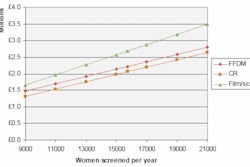VIENNA - The Irish BreastCheck National Breast Screening Programme's transition to full-field digital mammography (FFDM) has resulted in a statistically significant increase in breast cancer detection rate, according to a presentation at the European Congress of Radiology (ECR).
Following adoption of FFDM, the program's breast cancer detection rate climbed from 5.21 to 6.3 per 1,000 patients. FFDM has also found more invasive cancers and produced an increase in the proportion of ductal carcinoma in situ (DCIS) cases, said BreastCheck Clinical Director Dr. Fidelma Flanagan.
Flanagan described the 10-year experience of the national breast screening program during a Saturday satellite symposia sponsored by Swedish PACS and digital mammography vendor Sectra.
Debuting in 2000 initially with a pilot program, the Irish breast screening program has now performed 10 years of screening, providing more than 690,000 free mammograms to 325,700 women. More than 4,000 breast cancers have been detected, she said.
The program's shift from analog film-screen mammography to FFDM was completed in 2008.
"Although we are a small country, we were the first country in the world to boast that we had a fully digitized national breast screening program," Flanagan said.
Since 2008, the program has assessed the performance of FFDM and compared it with results achieved previously with analog systems.
"Overall, we were quite happy to find that the standards which we had set [for ourselves] with analog had been surpassed by the introduction of digital," she said.
The significant increase in cancer detection rate (from 5.21/1,000 using analog systems to 6.3/1,000 with FFDM, p = 0.01) supports findings from other studies and suggests that a broader category of women may benefit from FFDM than was previously thought from the American College of Radiology Imaging Network (ACRIN) Digital Mammographic Imaging Screening Trial (DMIST), Flanagan said.
FFDM has picked up more higher-grade tumors than low-grade tumors, she said. And as has been commonly experienced by other FFDM users, the technology has led to an increasing trend toward a higher proportion of DCIS (as a percentage of overall cancer found).
Percentage of DCIS of overall cancer
|
While the increase during initial screening was not statistically significant, it was for subsequent screening (p = 0.02).
Grading of DCIS has not changed in a statistically significant manner, however.
"The DCIS we're picking up is still high-grade or intermediate-grade, and we're not picking up the low-grade DCIS more than the high-grade," she said. "As we all know, it's the high-grade and intermediate-grade DCIS that are the ones that are more likely to develop into invasive cancer," she said.
No significant difference has been shown for detection by tumor size or lymph node status from the change to FFDM, she said. Digital systems did produce a statistically significant increase in detecting microcalcifications and invasive cancers.
"So the biological impact of digital is that we are picking up more cancers that tend to be more high-grade DCIS or higher-grade tumors," she said.
However, the program has experienced one of the common downsides of FFDM: a higher recall rate (4.0% versus 3.1% with analog, p < 0.001).
The program utilizes four static screening centers and 16 mobile units, and has deployed three types of FFDM systems: GE Healthcare's Essential, Hologic's Selenia, and Sectra's MicroDose Mammography.
The researchers evaluated the performance of the three systems in a selected patient cohort. No significant difference in cancer detection rate among the three FFDM systems has been found, Flanagan said.
In addition, the mean glandular dose for all patients was within targets and well below the standard set by European guidelines, she said.
"This was across the board and across all of the equipment," she said.
Flanagan noted that differences do exist between systems when image quality is measured via objective parameters.
"Perhaps a more combined approach where we use clinical performance and objective parameters is probably the best way forward [for evaluating systems]," she said.
The Irish BreastCheck National Breast Screening Programme is a success story, Flanagan said.
"We have currently a robust, quality-driven service," she said. "It is a platform for future development of other technologies, and I firmly believe that we will have an impact on the Irish population and an impact on other cancer services in the country."










